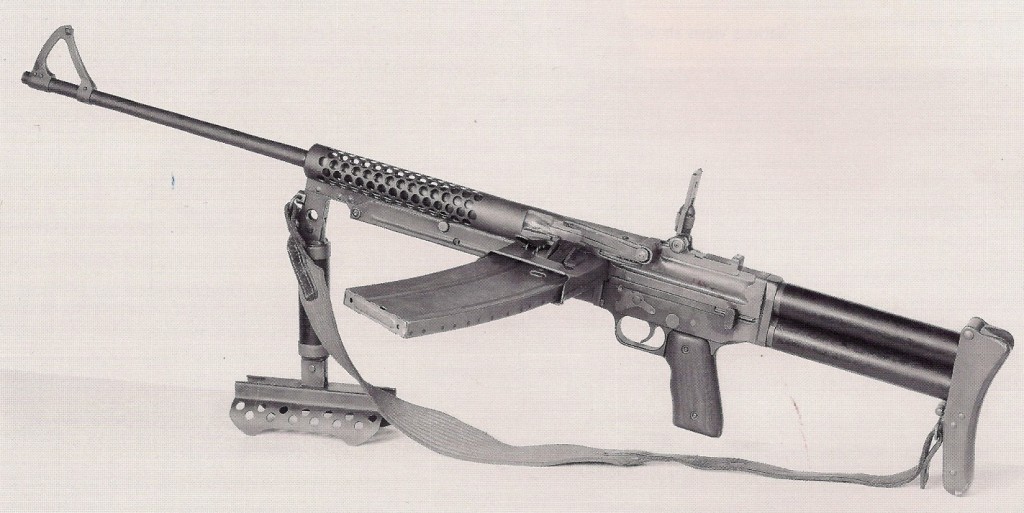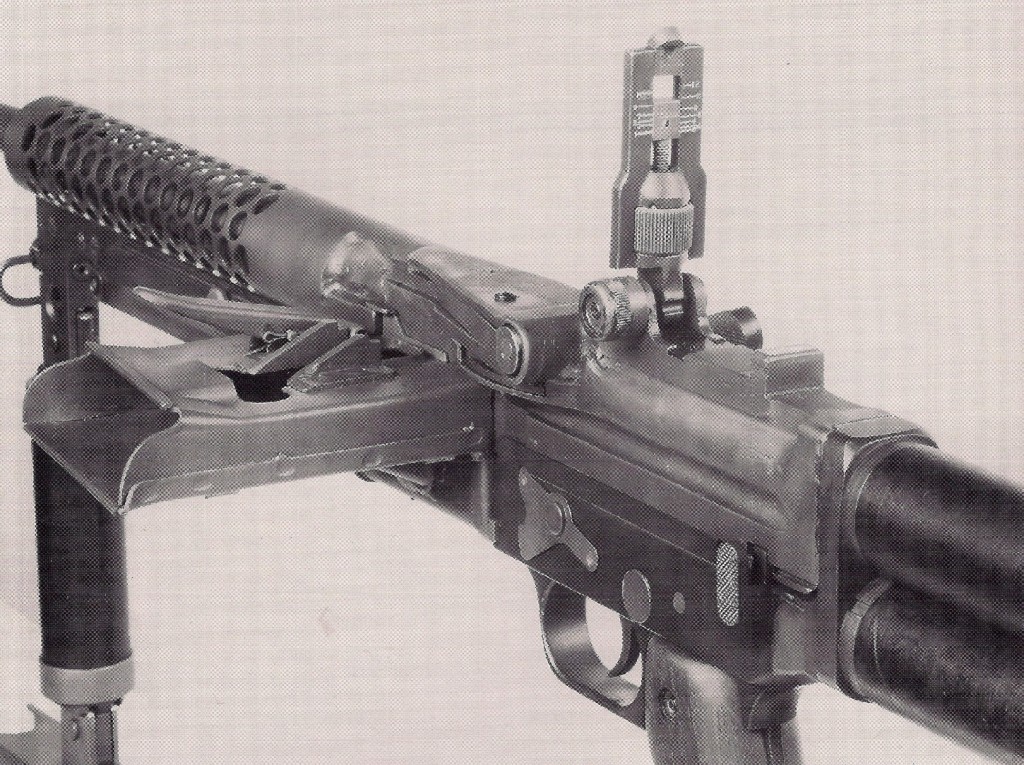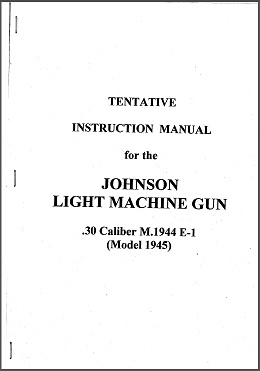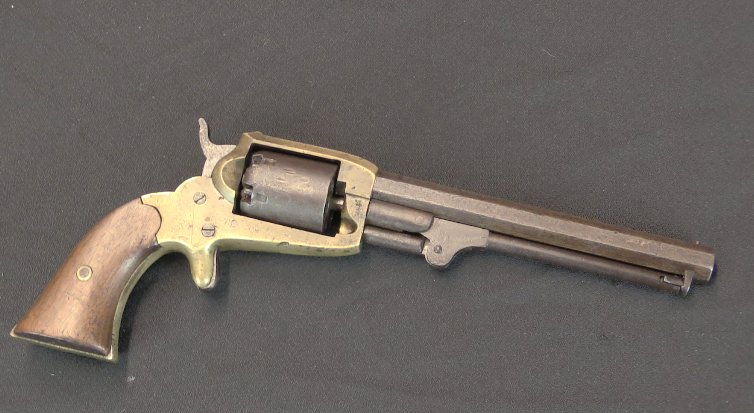In addition to his work on designing a basic infantry shoulder rifle, Melvin Maynard Johnson and put a lot of effort into creating a light machine gun for US military forces to use. In terms of US military usage, he was actually more successful with the LMG than the rifle – the Johnson M1941 LMG was officially adopted and used by the 1st Regiment of Para-Marines and the First Special Service Force. Chasing hopes of wider adoption, Johnson continued to refine his light machine gun, and eventually finalized the M1944 variant.
The M1944 Johnson LMG used that same basic action as the 1941 rifle and LMG, but included a number of useful improvements. The bipod on the 1941 LMG had to be removed to change the gun’s barrel, and this was a definite problem. The 1944 model fixed that, and replaced the conventional two-leg bipod with a creative folding monopod. This monopod could be used to stabilize the gun when firing prone (it’s foot had two spade-like wings to dig into the ground), and could also be folded up to use as a horizontal front grip, with the foot forming a supplemental heat shield to protect the shoot’s hand from the barrel shroud. The M1944 LMG also replaced the wood stock with a pair of tubes and a metal buttplate. The buttplate could be pivoted up to allow access to the tubes, which contained the weapon’s mainspring and a cleaning kit.
In December of 1943, ten of the M1944 light machine guns were delivered to Aberdeen Proving Grounds for formal testing. The guns exhibited problems under adverse conditions (sand, rain, mud, and cold) in those tests, but performed quite well in a following test at Quantico for the Marine Corps Equipment Board. That Board actually recommended the M1944 Johnson LMG to replace the BAR in Marine Corps service, but the recommendation was rejected by the Marine Corps Commandant, largely on the grounds that the Army had not adopted the weapon, and this would complicate logistics.
Johnson carried on improving the gun nonetheless, looking to resolve the reliability problems reported in the Aberdeen testing. His next iteration of the gun was the M1944E1, later renamed the M1945. With the design, he finally departed slightly from the original operating mechanism of the gun.

One will recall that the Johnson mechanism was a short-recoil system, with the bolt and barrel both reciprocating back into the receiver a short distance with each shot. Presumably the reliability problems discovered in adverse conditions were caused by excess friction (from mud or sand) preventing the barrel from recoiling far or fast enough. Johnson’s solution in the M1944E1 was to drill a gas port in the barrel bearing. There was no tube connected to this gas port; instead it vented against the barrel support in the receiver (8 inches forward of the chamber), and gave the barrel an additional push rearward when fired.

This gas assist provided the additional energy to cycle the gun reliably in more adverse conditions, and it also upped the cyclic rate to 600-700 rounds/minute. This extra force also required a modification of the bolt locking system in the form of an added spring and lever, to prevent bolt bounce in automatic fire.
Johnson sold ten toolroom prototypes of the M1944E1 to the US Army for $44,838 (complete with accessories and spare barrels) in late February of 1945, and one of them was put through a 20,000 round endurance trial from July 20 through August 6, 1945. The trial was not successful, and the trial was stopped after 13,190 rounds. The main problem was an excessively high rate of fire, most likely caused by an oversized gas-assist port. Thirteen parts broke during the abbreviated trial, including extractor, hammer, bolt locking cam, bolt lug cam, mainspring tube, firing pin, and cocking handle. Further trials were conducted with two of the other guns, but the Japanese surrender on September 2nd 1945 took all the urgency out of the program and testing ended in October of that year.
I have a copy of the tentative manual written for the M1944E1 / M1945 Johnson LMG, which you can download below. Unfortunately it has pretty dark illustrations and some text cut off (it’s a scan of a photocopy), but it should still be entirely readable.

References:
Canfield, Bruce. Johnson Rifles and Machine Guns. Mowbray, 2002.




“The 1944 model fixed that, and replaced the conventional two-leg bipod with a creative folding monopod.”
The monopod idea could be copied from early Boys .55 AT rifle. As you can see here:
http://www.youtube.com/watch?v=AlJD0pZp4eQ
early models of Boys have inverted T-shape monopod.
Dumb question: Given the somewhat odd appearance of the Johnson, would it likely be mistaken for a space-age movie prop? With little to no resemblance to conventional arms of the period, a casual viewer from the present might think this light machine gun was fake.
What were the numerical test-performance results of the Johnson? I’d like to know.
Maybe to someone with minimal experience it might, but the sideways magazine does make it still look relevant to the times for me.
Also this website might help us find more info on the Johnson, I’m at school right now so I can’t check it out myself.
http://www.johnsonautomatics.com/History.htm
There were other similar guns at the time, including the Swiss Furrer, Swedish M40 and Knorr-Bremse.
I forgot the FG-42… which I believe was used in the original “Star Wars”.
Not sure which movie in the series it was – I grew up reading Golden Age Science fiction and the Star Wars space-westerns made me howl with equal parts of pain and derisive laughter – but there is at least one (and I think it is the original – where the Imperial Storm Troopers go trotting hither and yon carrying Sterling L2A3 submachineguns. The Sterling has a side magazine as well. I don’t recall seeing any FG-42s but it would have made a sensible movie companion to the Sterling.
In the first movie released (now called “Episode IV”) there were a lot more guns than the Sterlings, and a lot rarer ones too. I don’t have my “World’s Submachine Guns” with me, but I believe there was at least one BSA(?) prototype gun in the movie (the one that used the foregrip as a charging handle), along with MG-34s, Lewis Guns and others. You’d think that somebody knew somebody at the Royal Armouries Pattern Room.
Rebel forces on Hoth may have used FG42’s during the Imperial assault. Stormtroopers were mostly armed with modified Sterlings, MG34’s and MG15’s …I believe The rebels also fielded Lewis guns.
Stormtrooper guns: http://www.looksirdroids.com/davin_weapons.htm
…god I’m a nerd.
The gas assisted short recoil system is quite interesting. Anyone know if it’s been used on other guns?
Soviet experimental Shpitalny Model 1940 submachine gun uses “blowback gas assitsed” principle:
http://warszone.narod.ru/weapons/Russia/pistoleti-pulemeti_i_avtomati/Shpitalnii_1940/shpitalny1940.html
(photo of SMG without magazine) The Shpitalny SMG was outperformed by Shpagin SMG (i.e. PPSh-41) due to the time of production – Shpagin SMG could be produced in 5.6 machine-hours and Shpitalny SMG – in 25.3 machine-hours. However, the SMG was considered worth to develop, but when the war broke out all long-term projects were stopped.
Note: The Shpitalny SMG is sometimes called PPSh as a abrevation from “Shpitalny SMG”, but the Shpitalny and Shpagin are two different designs.
Muzzle mounted “Recoil intensifiers” which trap some of the muzzle blast and use the pressure of that to give extra thrust to the recoiling barrel – were quite common, particularly where the gun had to drive a belt feed too.
I’m not aware of any other examples of the system used by Johnson (there may well be some, I just don’t know about).
Looking at the raised front site mount, and the half length barrel shroud, the Johnson doesn’t look like an easy candidate for a muzzle mounted device, even though a muzzle mounted device removes the need to drill the barrel, and is not sensitive to the size of that tapping.
As a Johnson-aholic for the last 30 years….I’ve owned and sold a few of the 1941 LMG’s. As a Title 2 mfgr….I made many 1941 Johnson semi-auto LMG’s (until I ran out of magazine trays). One of my first registered 1941’s started out as a 1944 Model reciever (no barrel or parts) that I bought from Numerich Arms. The only info I could find was a red-cover booklet on it…written in French. It had the gas-assist barrel locking system in it….but not the bolt-bounce device. Otherwise the reciever looked like a standard 1941 LMG. I ended up taking the 1944 gas-assist barrel lock mechanism out and putting in the standard 1941 barrel locking system….and other compnents. Eventually building a complete 1941 LMG….that I shot for years. I still have the 1944 parts….and they are for sale. Oh….and I have other 1941 Johnson parts….semi & LMG. And I have “one” barrel.
Oh….I even built some Israeli DROR semi-auto Johnson’s in 8mm Mauser and .303 Brit.
David
Amazing testimony. My Respect goes to you!
“Title 2 mfgr….I made many 1941 Johnson semi-auto LMG’s”
>ME WANT<
Now David, why did you have to let me know that some semi ’41 LMG’s exist out there somewhere?
It puts me in the uncomfortable and rather conflicted position of:
A) wanting one desperately now, when 5 minutes ago I was perfectly happy thinking so such thing existed,
and
B) wanting to hug a complete stranger for building the damn things.
hi there , do you have any 1941 Johnson lmg semiautos for sale I am very interested email or call me 484 614-9878
I am interested in finding a johnson upper receiver that could be converted to the “DAISY MAE” of which johnson made only ten of and in Mr. canfield’s book.
The gas assisted method, is in essence a recoil booster from an Mg42 or indeed a Maxim but unlike them it isn’t at the muzzle. Reasonable layout that Johnson, I like it. You could have a barrel like that of a FN MAG but turn the gas port around to function in this manner, in conjunction with a Mg42 type action built around a frame similar to this barrel return spring in the upper tube comprising of the stock and the bolts one in the lower.
I like Mr. Johnson’s rifle design. The LMG version, as thoughtful as it may be, is a bit of stretch. I believe that one weak point already existing on rifle was lack of momentum transfer form barrel to bolt. That eventually showed in LMG application and was somewhat solved as author of article explains. Otherwise his genius is undeniable and I consider him as a grand-father of M16 rifle.
Why do you think he was “The grandfather of the M-16 rifle”?
I am just curious because I can not think of any similarities between the two??? Direct gas impingement Vs short recoil tilting block, etc?
The locking lugs – Johnson worked with Stoner for a while.
Ah the Dror, hmmm… Well after looking at the link Aj posted in regards Mr Johnsons other weapons you can certainly see the M16 coming about.
Those seven lugged bolts however, having some experience with the British SA80 A1 and A2 I do have some reservations about that particular design.
That cavernous chamber in front of the breech hidden by all the wee lug “stops” is prone to fouling, residue and together with oil causes the forward assist problem in my opinion by creating resistance via compressing the air trapped in said chamber. Or friction or something, but the bolt suffers from an inability to return completely into the breech frequently.
Your AR rifles have a similar problem apparently hence the addition of a forward assist bolt, because your cocking handle isn’t attached to the bolt carrier were as we just wack the cocking handle. The SA80 uses a gas tappet not direct impingement, so I would be surprised if a tappet would solve the AR’s problems in this regard. The triangular’ish bolt on that Australian arms SAC is a better design I think when using the “not alot of travel” turn, cam stud/groove turning method.
There’s a distinct lack of “umph” generated by the gas tappet on the SA80 in relation to the bolt carrier and the strength of it’s return springs, If the carrier was attached to a long stroke gas piston I think this would help deliver a more positive rearward motion.
The direct impingement on the AR uses gas theoretically “as is my understanding” to act upon the bolts rear inside the carrier via it’s gas actuator ring thing, to impart a rearward motion upon said carrier which turns the bolt via a cam stud/groove arrangement between them.
On the SA80 I suggest using a AR gas pipe modified so it acts as the gas plug directing gas down the pipe, into a gas cylinder. The cylinder is now located inside the bolt carrier, the cylinder is modified to have a squared edge “to prevent it turning” and this terminates in a protruding lug. The carrier is cut to facilitate this, behind the cylinder the old gas piston rod/spring is turned around and mounted inside a notch within the cylinder and to a new section within the frame allowing the rod to compress within the receiver.
In so doing facilitating the cylinder to move inside of the carrier, while the bolt remains locked. The gas pipe runs inside the cylinder you understand, to about an inch from it’s end. A hole is drilled through the cylinder forward of the pipes end approximately 1″ from the carriers front, this would correspond with a hole through the carriers side when the cylinder is to the rear thus venting out of the ejection port. Given the cylinder extends the same amount to the carriers front, upon firing the gas would enter the pipe via a port as per “possibly further away from the muzzle” it would enter the cylinder compressing it’s return spring via the guide rod, when the cylinders forward lug contacts the bolt and therefore moves the carrier back in so doing turning the bolt, the hole in the cylinder is inline with that in the carrier gas vents bolt unlocks. Using stronger bolt return springs I am under the impression this would create more “umph” rearward impetus upon the carrier giving a faster and more positive return and lock up. Because the gas is not vented until the bolt is in motion, while the bolt hasn’t unlocked but it is about to at this point.
The pipes end remains enclosed throughout…
Anyway looking at the AR’s carrier I think you could fit a similar system to that, I am suggesting replacing the angled piece which protrudes from the upper portion of the carrier into which the gas pipe sits. Into a separate piece, a cylinder. The cylinder would run above the space for the hammer, and the gas pipe would run inside it. The rear of the cylinder would form a plate with a rod emanating from it, it would sit below the cylinder. A spring would fit around this and the rod would fit into a hole drilled through the rear of the carriers hammer cut out, the spring would compress against this hole and the rod end of the cylinder would pass through it and into the gap within the main spring “via a hole in the buffer thing if that’s what it is between the spring and the carriers rear” the cylinders length would be dictated by how much of the carrier goes into the tube for the return spring when the cylinder has returned forward. The cylinder would possibly have groves on it’s underside to run on rails cut into the forward section of the upper carrier, and the front of the cylinder would protrude forward of the carriers front edge and it would have a lug to engage this upon moving rearward. So a hole in the cylinder drilled forward of the end of the pipe by say an 1″ would vent via a hole in the receiver above the ejection port. The inside of the receiver would be formed so as to partially surround the cylinder to facilitate this, might work just a thought. Point being “umph” fire, gas into cylinder, cylinder moves rearward, lug engages carrier, carrier moves rearward bolt turns, gas vents, bolt unlocks quicker in theory, but not to quick, strengthened return springs, more positive lock up.
If you have a shed in the U.S feel free if you think you might be able to work something out of my suggestion.
Then angle the forward edge of each lug so each is more diagonal, in an attempt to free up more space inside the breech to counter whatever is happening.
Possibly that was a bit prolonged, I bet you guys could help however.
Were does the gas in the AR go ie. Is it just vented into the receiver after the carrier moves rearward or out of the ejection port?
Hi Stewart
This topic was run here on FW several times. It is more than 8-lug bolt, it is also straight line concept (compare this LMG and M16) – same idea. True, FG-41 is also along that line. But mainly, it is known that M. Johnson was working for Arma-lite as a contractor, incidentally while one of employees in R&D was E. Stoner. There is no doubt, M.J. influenced E.S’s thinking to significant degree.
Missing an accelerator (or a toggle)
Nice gun, copied from the german FG 42 and ancestor of the M60
How did you figure that out?
The Johnson has a different operating principle, different feed system and it pre-dates it.
The FG42 was copied from the Lewis gun as far as operating principles are concerned. Other than that, the side-mounted magazine, the ability to fill the magazine through the action with rifle clips, firing from a different bolt position on semi and full auto, and the straight-line layout, they have nothing in common. If anything, the Johnson is the father of the M16. In fact, very early prototypes of the Stoner design looked very similar to the Johnson.
IIRC, the Lewis gun, a great LMG by the way, was gas operated, with a rotating bolt, used clockwork springs that could be wound tighter, or loosened to regulate the rate of fire, fed from pan magazines and because of the finned BBL inside a shroud, did not need to change the barrel under normal use!
I think an updated version made from stamped sheet metal with normal springs and a “squirrel cage belt feed” would make a great LMG by any standard today!
There was an updated Lewis produced by the Soley Armament Company of England (which has an interesting history itself involving selling arms to countries all over the globe) in the 1930s.
There were 2 versions (no pictures online that I could find, but they can be seen in the back of the book Machine Guns, by Ian Hogg). The early version was a standard Lewis converted to feed from a BREN box magazine, but still retained the original recoil spring and an aluminum radiator of reduced dimensions compared to the original. The later version also fed from a BREN magazine, but used a normal recoil spring around the gas piston, had no radiator, and had a cone-shaped flash hider.
If you like the Johnson rifle. This one is even better! “Daisy Mae” was only a prototype but she is sweet.
http://milpas.cc/rifles/ZFiles/Semi-automatic%20Rifles/US/Johnson%20Carbine/Johnson%20Carbine.htm
I’ve often thought that “Daisy Mae”, fitted with a M1941 LMG-type magazine, or a larger drum holding 20-25 rounds, would have made an interesting “answer” to the German Haenel Maschinenkarabiner family in 7.9 x 33mm Kurz.
Controllability in full-auto would have been better than the BAR, in spite of lighter weight, due to the “straight-line” recoil axis. And a “carbine” with the full power of the .30-06 round would have been very useful for armored troops, etc.
The M1 Carbine tended to win gunfights with SMG-armed opponents, simply by outranging and out-powering them. A “Sturmgewehr” Daisy Mae could have been a nasty shock for German troops who thought they had U.S. troops armed with “carbines” on the wrong end of a similar equation.
cheers
eon
Melvin Johnson seem to be one of those little known but very talented gun designer. While I don’t believe his M1941 rifle offered enough over the M1 Garand to be considered for large scale adoption, his M1941/1944/1945 LMG designs certainly could have been suitable replacements for BAR.
Did he ever test a belt-fed variant of his LMG? Once refined that could have offered a suitable starting point for a GPMG, as opposed to the FG42 inspired T44 which eventually became the M60.
BTW I’ve seen a lot of conflicting information about the standard magazine capacity for the Johnson LMG, did they contain 20 or 25 rounds?
Both. The magazine itself contained twenty rounds, but there was room for another five in the action, so twenty-five in all with one round in the chamber.
There were three different belt-fed models based on Johnson M1945 LMG: the T40, T48, and T53. They didn’t progress very far in post-war testing.